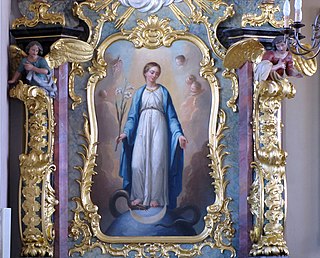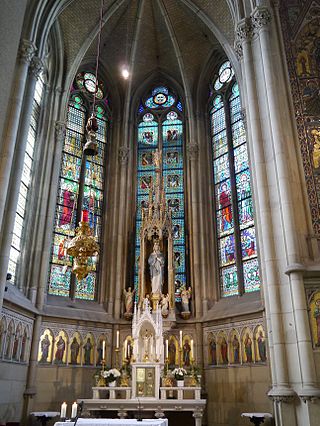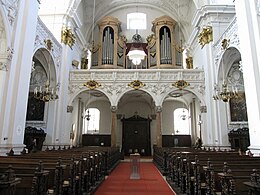
Ecce sacerdos magnus, WAB 13, is an 1885 sacred motet by the Austrian composer Anton Bruckner. It is a musical setting of the antiphon of the same title.

Virga Jesse, WAB 52, is a motet by the Austrian composer Anton Bruckner. It sets the gradual Virga Jesse floruit for unaccompanied mixed choir.

Afferentur regi, WAB 1, is a motet, which Anton Bruckner composed on 7 November 1861 on the text of the Offertorium of the Missa pro Virgine et Martyre.

Vexilla regis, WAB 51, is the final motet written by the Austrian composer Anton Bruckner.

Tota pulchra es, WAB 46, is a sacred motet by the Austrian composer Anton Bruckner.

Locus iste, WAB 23, is a sacred motet composed by Anton Bruckner in 1869. The text is the Latin gradual Locus iste for the annual celebration of a church's dedication. The incipit, Locus iste a Deo factus est, translates to "This place was made by God". Bruckner set it for four unaccompanied voices, intended for the dedication of the Votivkapelle at the New Cathedral in Linz, Austria, where Bruckner had been a cathedral organist. It was the first motet that Bruckner composed in Vienna. It was published in 1886, together with three other gradual motets.

Ave Maria, WAB 5, is a setting of the Latin prayer Ave Maria by Anton Bruckner.

Christus factus est, WAB 11, is a sacred motet by Anton Bruckner, his third setting of the Latin gradual Christus factus est, composed in 1884. Before, Bruckner composed in 1844 a first piece on the same text as gradual of the Messe für den Gründonnerstag, and in 1873 a motet for eight-part mixed choir, three trombones, and string instruments ad libitum. The motet is an expressive setting of the gradual, influenced by Wagner's music.

In jener letzten der Nächte, WAB 17, is a motet composed by Anton Bruckner.

Os justi, WAB 30, is a sacred motet composed by Anton Bruckner in 1879. Os Justi is a Gregorian chant used as gradual of the Commune Doctorum, and as introit I and gradual II of the Commune Confessoris non Pontificis.

Libera me, WAB 21, is the first of two settings of the absoute Libera me, composed by Anton Bruckner in c. 1843.

Tantum ergo, WAB 32, is the first of eight settings of the hymn Tantum ergo composed by Anton Bruckner in 1845.

The four Tantum ergo, WAB 41, are settings of the hymn Tantum ergo composed by Anton Bruckner in 1846.

Tantum ergo, WAB 42, is a setting of the hymn Tantum ergo composed by Anton Bruckner in 1846.

The Two Aequali, WAB 114 & WAB 149, were composed by Anton Bruckner in 1847.

Salvum fac populum tuum, WAB 40, is a motet composed by Anton Bruckner in 1884.

Pange lingua, WAB 33, is a sacred motet composed by Anton Bruckner in 1868. It is a setting of the Latin hymn Pange lingua for the celebration of Corpus Christi.

Inveni David, WAB 19, is a sacred motet composed by Anton Bruckner in 1868.

Du bist wie eine Blume, WAB 64, is a song, which Anton Bruckner composed in 1861.



















